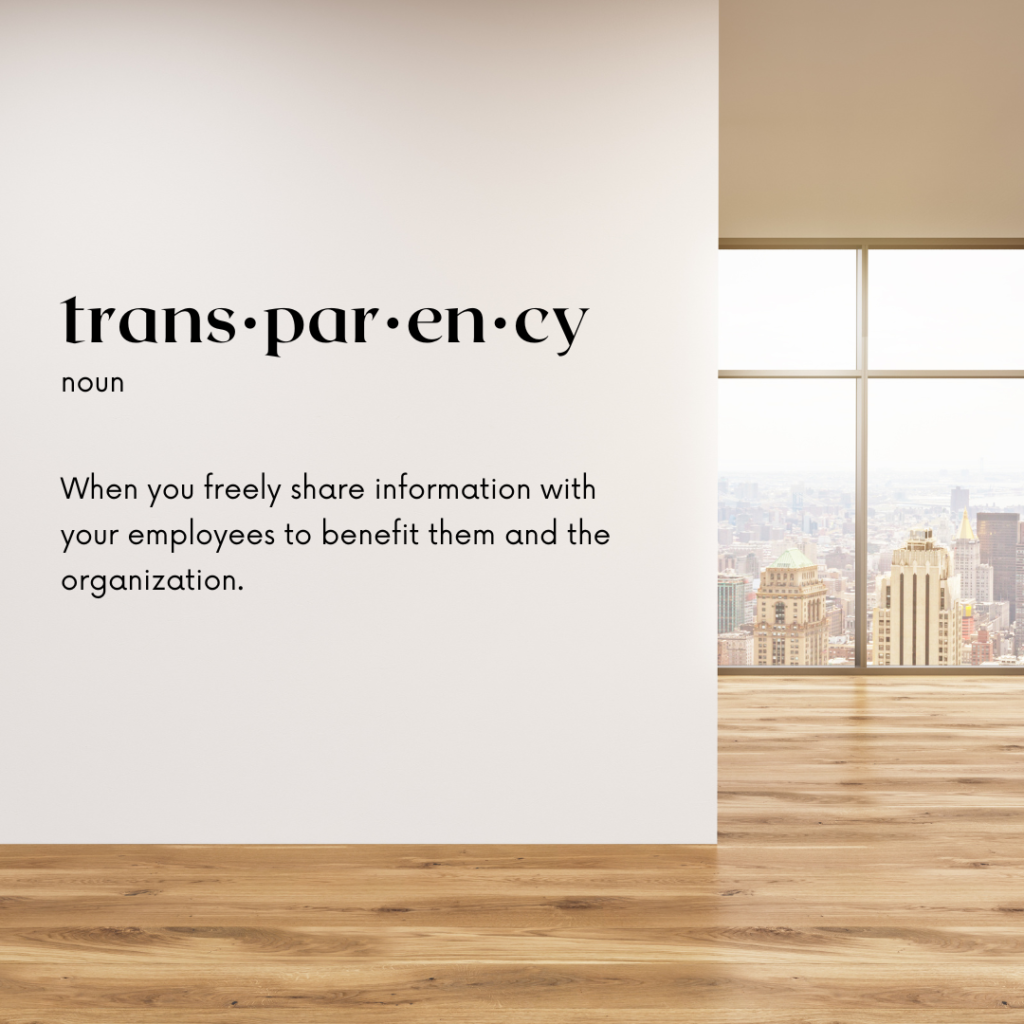HR Theme For 2024: Transparency
Posted by Trakstar • January 4, 2023 (Last modified August 15, 2023) • 6 min read
There’s always a weird feeling in the air about a new year. While many people have hope and aspirations about the next twelve months, there’s an underlying feeling of fear and trepidation for what could be – what if this year isn’t good? What if we don’t achieve our goals? What’s going to happen? This year, HR and people leaders of all kinds need transparency about how things are going, what changes will be made, and what people can expect.
If you don’t have transparency, your workers will disengage, worry, and perhaps even start looking for new jobs. Sure there are things people cannot know or should not know, but how can you focus on being more transparent in the new year?
We’re here to help! Below, we’ve outlined ways to be more transparent with your employees without telling them too much. If you’re looking for an end-to-end talent development platform that makes transparency, accountability, and engagement easy, consider scheduling a demo of the Trakstar platform today.
What is Transparency in the Workplace?
Workplace transparency, especially from HR, is the idea that you freely share information with your employees to benefit them and the organization. This doesn’t mean sharing everything but sharing some of the information you have. It may not mean sharing company-wide information either, but instead telling one or two employees who need to know things.
Why? This information can help keep people focused on the right goals, increase communication, and provide a “why” for the organization’s actions.
While we can’t share everything with everyone, being open is a great way to maintain a transparent culture, set boundaries within departments and the organization, and manage expectations and performance results.
Transparency May Not Come Naturally – That’s Okay
For so long, HR has had to keep things under wraps. Managers were privy to some information, but not all, and they couldn’t always share what they knew with their teams. A lot of this is generational: nothing was shared with them when they were employees, so they aren’t going to share anything when they become managers.
So how can you make the shift? There will be some growing pains you’ll need to account for – and some you will only be able to plan for once you’re in the thick of it. But that’s okay; making an effort is enough for most employees to forgive some of the missteps.
When becoming transparent, you need to set boundaries. What is safe to share, and what isn’t? Being too transparent can cause as many problems as not being transparent at all. You want to find the happy medium but also be able to explain why there are limits on some information.
If you take this on as your theme for 2024, know that there is a learning curve, and you will make some mistakes. Sometimes you’ll share things you should not have – and that’s okay (as long as it is legal and moral – always check when in doubt).
How To Create Transparency in HR
So how can HR be more transparent in the new year – and create a culture of transparency that lasts longer than 365 days?
There are a few areas where you can start your focus.
Start With Transparency In The Hiring Process
The hiring process is the first area where you can start being more transparent. You want to ensure that candidates know what they’re getting into when they apply for a job with your company. What makes your company unique? What makes you special?
Being more transparent and inclusive with your job postings is a fantastic place to start. Be sure that you’re listing all of the requirements of a position. When you have interviews, and someone asks a question, be as transparent as possible with the answers.
This is especially true if there are rumors about your company or if you have a specific reputation – talk about it!
Onboarding Ingratiates A Transparent Culture
The next place you want to be transparent is in the onboarding process. The more transparent you are during this time, the more likely your employees are to fall into that culture and be transparent with you.
Be clear about your organization’s policies, expectations, and goals. Be clear about how people will be evaluated and how they’ll know if they’re meeting those expectations. Make sure that everything is predictable – if you have yet to tell someone something, they will find out at some point anyway.
If you’re not onboarding your new hires (which could be a huge mistake, you can read more about that here), then you need to be transparent about that. If they’re not being trained, then let them know what they can do to fill the gap. This will save time and heartache later when they find out that things aren’t going as smoothly as they thought.
Talk To Your Employees
How often does your C-suite sit down and talk to employees about how the organization is going, what challenges you’re facing, and where you think they’ll be in 6 months or even a year? If you can’t remember, it may be time to do it! Send members of the C-suite into department meetings to discuss departmental goals, struggles, and concerns. This doesn’t just have to be the department that reports to that specific member of the C-suite! You can also hold individual meetings, pot-luck meetings, or company-wide bonding activities to help bring that sense of community.
This isn’t just a good idea because it fosters a sense of community and transparency and allows you to get feedback on how things are going. You may not have thought about it from this perspective, but employees can also be your best source of information regarding how well you’re doing!
Cultivate Transparency Through Performance Reviews
Performance reviews are a great way to create a transparent workforce. Your employees should know what they are being graded on and how that will impact things like pay raises, promotions, performance improvement plans, and succession.
Managers can be transparent about what they’re looking for and, when they complete reviews, how they feel about the work the employee is doing.
You may want to consider a “no surprises” policy. This means that you’ll tell your employees anything they need to know before they’re on the hot seat. For example, if an employee is going to be evaluated by their peers using 360-reviews, then let them know before it happens. If an employee is going to be evaluated by someone who isn’t their boss or manager, then let them know, so there’s no confusion when the evaluation period begins.
Ready For a Culture of Transparency?
Is your organization ready to start being more transparent? Trakstar is an online performance management solution that helps employers set and track goals across the organization, monitor performance, onboard new employees, make smarter hires, and so much more. Transparency isn’t easy, but the sooner you start, the better you’ll be.
Don't Miss Out on More Great HR Articles!
Subscribe to get the latest, greatest HR and Talent Development content straight to your inbox.




